Industrial companies—metal recyclers, printing plants, rail yards, petroleum refineries, and the like—have a smaller footprint on the land compared to residential areas and other businesses. But when rainstorms flush runoff from industrial sites, that contaminated stormwater can carry a toxic cocktail with an outsized impact on lakes, bays, and other sensitive waterways.
So the effort to clean up Puget Sound, to make it hospitable to marine life and safe for humans to fish and swim in, has focused on polluted stormwater—including industrial runoff.
But while government regulators and green-leaning groups are united in their stormwater worries, they’re surprisingly divided over the best way to curb the flow of industrial runoff. The rift has set natural allies at odds with each other over the degree to which polluters should be penalized or prodded into compliance.
The issue is front-and-center as officials with the US Environmental Protection Agency today are expected to announce a new wave of penalties for businesses with stormwater violations and as Washington’s Department of Ecology is releasing an updated version of the industrial stormwater permit.
Since August 2013, the EPA has issued stormwater penalties totaling roughly $1.4 million to a dozen Western Washington industrial facilities.
The sites include a cement company that for nearly 20 years released stormwater tainted with copper and zinc levels without a permit, a waste hauling company that failed to clean up spills and leaks, and an auto wrecker whose unpermitted stormwater runoff contained high levels of lead, petroleum, and other metals. In each case the violations spanned many years and ran afoul of industrial stormwater permits issued under the Clean Water Act.

Chesapeake Bay Program, Flickr Stormwater flows onto street, Annapolis by Chesapeake Bay Program
“These focused actions help bring us closer to restoring the health of Puget Sound,” said Ed Kowalski, director of EPA’s enforcement program in Seattle, in an earlier press release.
“It’s to deter non-compliance across a broad group of facilities,” said Jeff KenKnight, manager of the EPA’s water enforcement group in Seattle. “You want to make sure others are aware of that and learn from it.”
But groups favoring gentler strategies to encourage compliance—warnings, education, outreach, and technical support—are pushing back.
“Wielding the hammer is one tool, but what does it do?” said Kevin Burrell, executive director of the nonprofit Environmental Coalition of South Seattle (ECOSS). “I don’t think those interactions have been productive. It’s not going to solve the problem.”
Progress despite spotty enforcement
The stormwater program gets its authority from the federal Clean Water Act, but is managed by the state Department of Ecology. More than 1,100 facilities statewide have industrial stormwater permits, the great majority located west of the Cascades. The companies include sophisticated multinational corporations as well as mom-and-pop shops with a handful of employees.
In 1992, Ecology issued the first stormwater permit regulating pollution from industrial and construction sites. Later permits addressed industrial sites separately from construction. Over the years, business interests and environmental organizations have sued the state over the permits, arguing the rules were too onerous or not sufficiently protective of local waterways.
Today Ecology is releasing the latest version of the industrial stormwater permit, replacing one issued in 2010 and updated in 2012. The new rules go into effect in January.

Wonderlane, Flickr Universal Responsibility in a Matrixed Economic World by Wonderlane
The program requires permit holders to have a stormwater pollution prevention plan that includes strategies for reducing the contamination of rainwater runoff with toxic chemicals. The permit holders are supposed to collect samples of stormwater runoff from their sites and have them analyzed for pollutants. They’re required to report the pollution levels to Ecology on a regular basis. If the pollutants frequently exceed benchmarks set by the state, the company is supposed to install systems for cleaning up the dirtied rainwater before it streams off their site.
But Ecology, which has only 11 inspectors to oversee the program, has been spotty in its enforcement.
“There is widespread non-compliance with the permit,” said Chris Wilke, executive director of Puget Soundkeeper Alliance, an environmental group.
If a permit holder is not reporting their monitoring results, Ecology will send letters telling them to do so. The third letter can include a penalty. From January 2010 to March 2014, Ecology issued close to 3,500 notices and orders and 35 penalties. Two of the penalties were for $9,000 because the companies were repeat offenders; the other 33 were for $3,000.
If the company is releasing stormwater that misses the goals set in the permit, they are supposed to install treatment systems. But frequently, they ignore that order, said Jeff Killelea, industrial stormwater permit writer with Ecology. “That happens quite a bit.”
Despite the compliance challenges, Ecology officials and Puget Soundkeeper Alliance say the program is helping cleanup industrial runoff.
“We’ve seen some significant improvements,” said Bill Moore, Ecology’s water quality permits manager.
He acknowledges that it’s taken longer than many people would like. But for many permit holders its has been a steep learning curve to realize they’re polluting the rainwater runoff, that it has serious environmental consequences, and that they’re responsible for doing something about it.
“It’s a complete paradigm shift for a lot of folks,” Moore said.
Carrots and sticks
ECOSS and Puget Soundkeeper Alliance have helped drive that shift toward understanding and action. But the green-leaning nonprofit groups have taken significantly different approaches to get there.

Gerick Bergsma, Flickr. Stormwater discharge by Gerick Bergsma
For about 15 years, ECOSS has provided free technical assistance to businesses struggling with environmental issues, including stormwater pollution. The group began as an organization focused on South Seattle and the Duwamish River area. But it has expanded its reach and over the last five years has traveled statewide offering training to industrial permit holders trying to understand the stormwater rules.
“You should see how many ‘aha’ moments we have in our workshops,” Burrell said, as permit holders get a better grasp of the regulations. It’s often not an easy audience to reach.
“There is a fundamental cultural gap,” Burrell said, between permit holders and the regulators. While some businesses have the resources and knowledge to comply with the permit without much trouble, other companies, and particularly the employees responsible for meeting the permit requirements, “they have little or zero understanding of chemistry and physics,” Burrell said.
Lots of factors make compliance difficult. Some companies must deal with toxics from adjacent sites, such a transportation hub or other facility that generates air pollution that settles on their land and winds up in their stormwater. Other businesses have high employee turnover so they lose workers knowledgeable about their stormwater efforts.
“Life gets in the way of stormwater plans,” Burrell said.
Puget Soundkeeper Alliance tries to make sure that doesn’t happen, or at least not too much.
For years the group has fought for stronger stormwater regulations and brought numerous lawsuits. The group currently is pursuing 10 stormwater permit scofflaws.
Wilke, the group’s leader, said lawsuits make people take the permit seriously.
“It’s about cleaning up the water and putting in the corrective action,” he said. “If all elements of the permit are working, it can be effective.”
The permit’s pollution benchmarks are set at levels meant to protect marine life, Wilke said. Researchers have shown that untreated runoff collected from Seattle roadways can be so polluted that it quickly kills salmon. Less polluted runoff might not be lethal, but chemicals such as copper can deaden a salmon’s ability to smell, making it difficult for the fish to find food, avoid predators, and navigate its way to spawning streams.
So the environmental organization looks for industrial companies who have a record of failing to comply with their permit and are putting waterways and wildlife at risk.
The group informs the business that they’re planning to sue and sometimes can work out an agreement to fix the situation before going any further. If they take legal action, the settlements typically include a plan for correcting the stormwater problem, cover Soundkeeper’s legal fees, and fund a project to improve the environment to compensate for the harm the company has caused.
Puget Soundkeeper Alliance “has a lot of really good success,” said James Rasmussen, coordinator for the Duwamish River Cleanup Coalition, a nonprofit group.
Effect of EPA’s muscle
For the past decade or so, Ecology, ECOSS and Puget Soundkeeper Alliance have been the region’s dominant industrial stormwater players.
But with its recently pledged focus on industrial stormwater and spate of five- and six-figure penalties, the EPA has started flexing its regulatory muscles. Not everyone is impressed.
“They’re late to the party,” ECOSS’s Burrell said. With Soundkeeper and other groups already suing permit violators on a regular basis, many industrial companies know they’re at risk if they don’t comply with their permits.
“There is enough fear out there already,” Burrell said.
For his part, Wilke questions whether the EPA’s settlements are having tangible environmental benefits on par with the approach his organization takes. The money collected by the EPA, for example, goes to the US.Treasury rather than into restoration work in Puget Sound.
Ecology officials see the good and the bad in the lawsuits by both the EPA and Soundkeeper.
“It’s a mixed blessing,” said Ecology’s Killelea. The feds and environmentalists “are less inclined to issue warnings and offer assistance and move right to enforcement.” And while the threat of lawsuits “heightens the [permit holders] awareness,” he said, it can also make Ecology’s job harder.
The industrial facilities could be more inclined to push back against the updated, stricter permits, potentially filing legal challenges to the new rules as they have in the past.
“It makes permit holders more concerned about the permit conditions that we try to implement,” Killelea said.
KenKnight, of the EPA, defends his agency’s role. “There are many aspects to regulating a sector,” he said. “When we see noncompliance it’s our job to enforce the law.”
Unclear path to recovery
There are at least two things the government regulators and nonprofit groups can agree on in the arena of industrial stormwater permits:
1. Polluted stormwater runoff is a serious threat to Puget Sound and other waters.
2. In the past five or more years, industrial facilities as a whole have started paying more attention to their stormwater permits.
From there it’s harder to find common ground.
EPA, Ecology, and Soundkeeper more or less agree that the industrial stormwater program provides a sound regulatory framework. None would argue for only outreach or for penalties alone to make the program work; the solution is some balance between the enforcement and education.
“There’s room for improvement in both the wording of the permit and definitely in the implementation, but the underlying permit structure holds a lot of promise,” Wilke said. “We have made some great progress” reducing the amount of pollution that is running off industrial sites.
But while ECOSS is committed to helping permit holders comply with the permits, Burrell questions how much the program can deliver. He argues that some sites and businesses that should be regulated by the program are not, while others are included but have little environmental impact. He asks if industrial sites aren’t being held to an unfair standard compared to roadways, commercial parking lots and other land uses.
“We’re spending a lot of time and resources on 1,200 companies,” Burrell said. “If you fix all their compliance problems, I don’t think anybody is saying that is going to solve water quality problems.”
But could you solve pollution problems in Puget Sound and other Northwest water bodies without fixing the industrial sites?
A 2011 study by Ecology found that runoff from industrial sites carries the highest concentration of many dangerous pollutants, exceeding safety limits for humans or wildlife for copper, lead, toxic chemicals created in combustion, and others. Residential runoff, by comparison, was below the safety limits (see table 12). When comparing the total amount of pollution coming from industrial versus residential areas, however, residential land generates a larger volume of copper and oil and grease than industrial areas because it covers much more land (see tables 8 and 15).
Given the risk posed by industrial stormwater, EPA officials stand behind the penalties as an effective, necessary strategy.
“Everybody brings in different tools and methods to get to the same place,” said Mark MacIntyre, an EPA spokesman in Seattle. “By all of us pulling on the rope in the same direction it’s getting us closer to where we want to be, which is a cleaner Puget Sound.”

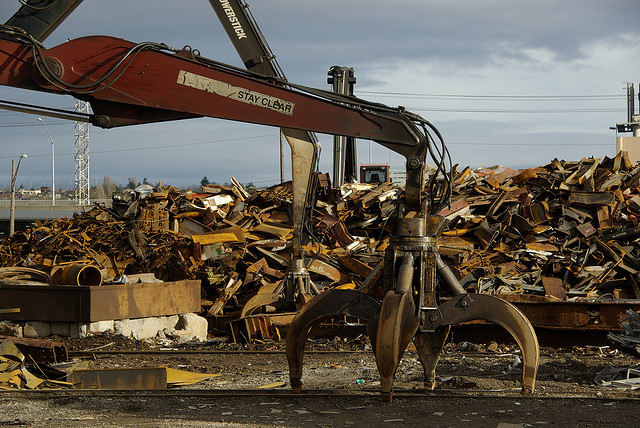
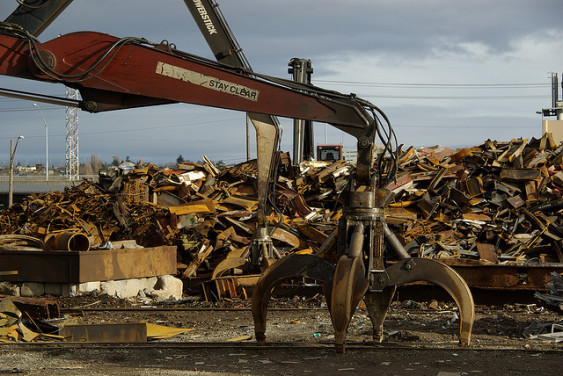

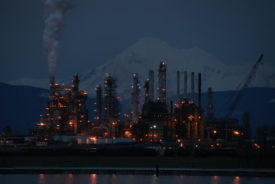
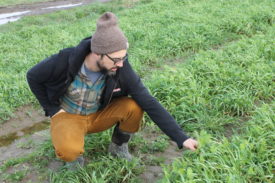
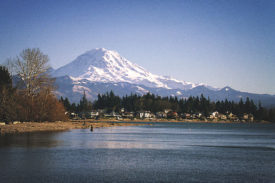
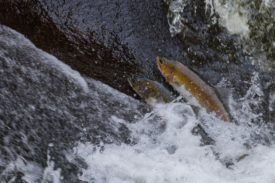
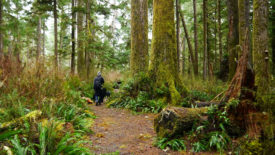


Muthrie
Yup! We keep hammering on the “industrial stormwater” nail, driving the bar for compliance up, up, up and forget the now larger stormwater issue is us .. the residential/ city portion of stormwater.
Former EPA Administrator William Ruckelshaus stated “85% of water quality impairments in 1970 were attributed to point source pollution, such as industrial and wastewater discharge, with the remaining resulting from nonpoint discharges, including agricultural and urban stormwater runoff. By 2010, these figures had reversed: 85% of water quality impairments now come from nonpoint discharge.”
harvey
Need to git on this and make people realize where the real problem lies.
As the oldest Marx Brother used to say, there needs to be an “conscieniousness raising.”
Elizabeth Graser-Lindsey
Unfortunately if storm water is cleaned up at a sewage (or “wastewater”) treatment facility rather than at the source, then the sludge (now called biosolids) that is separated to clean the water is applied to our crop land where produce and livestock are grown e.g. in my rural community adjacent to Portland. As it stands, we end up eating heavy metals.
The efforts to clean storm water need to be accompanied by attention to the sludge problem.
David Hymel
This is an excellent survey of the complexities enforcing the federal Clean Water Act in the Puget Sound industrial setting. We hope to see a plethora of promising solutions in the next blog. Thank you Lisa.
Steve Erickson
Historically, the two holes in the Clean Water Act have been explicit protection of wetlands and non-point pollution (including agriculture). However, this doesn’t let the traditional point sources off the hook. The description of the businesses targeted for enforcement by the EPA all sound like excellent targets because they are gross violators, not businesses that have been caught by an incremental increase in standards.
As for the perennial “carrots vs. sticks” argument,carrots only work if the alternative is a large stick.